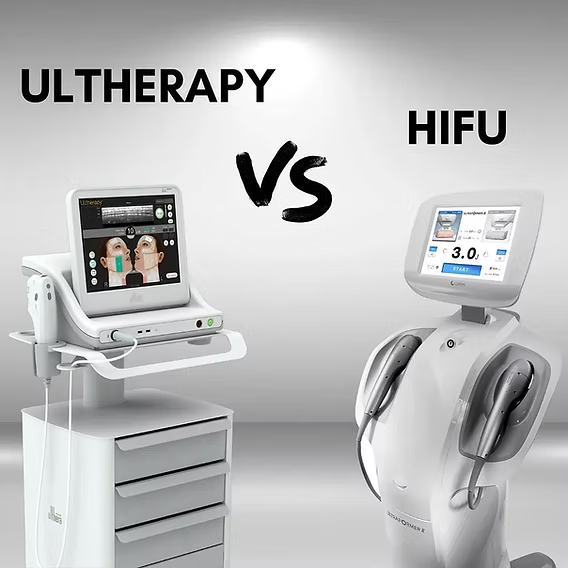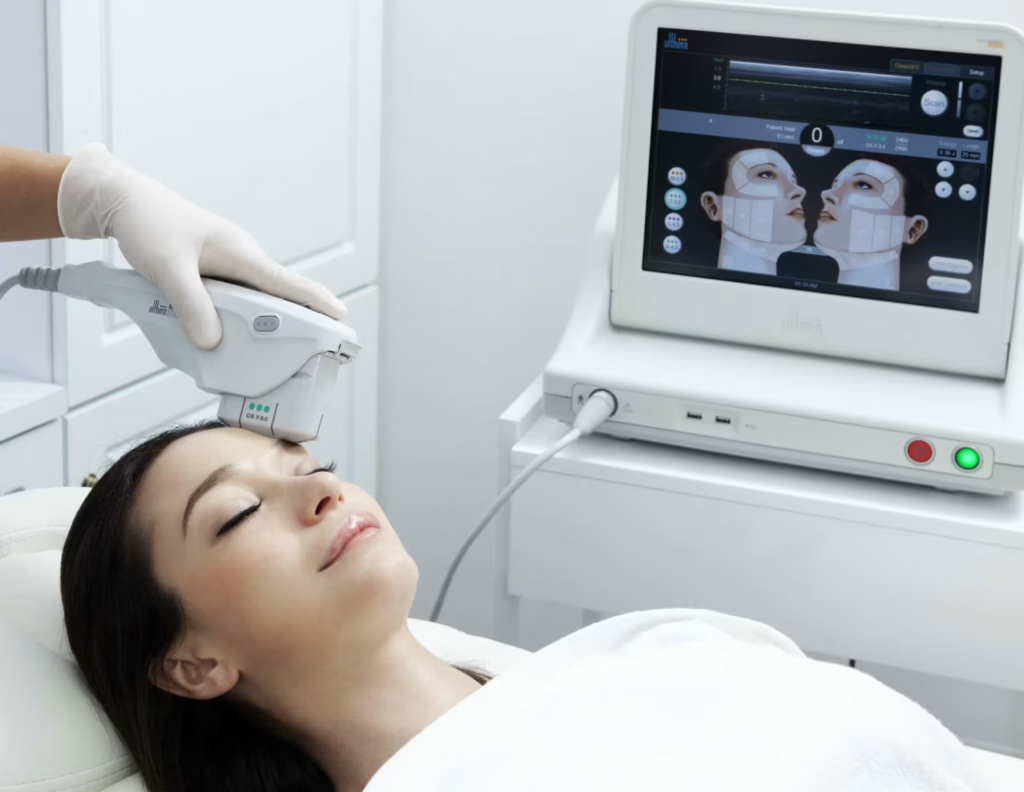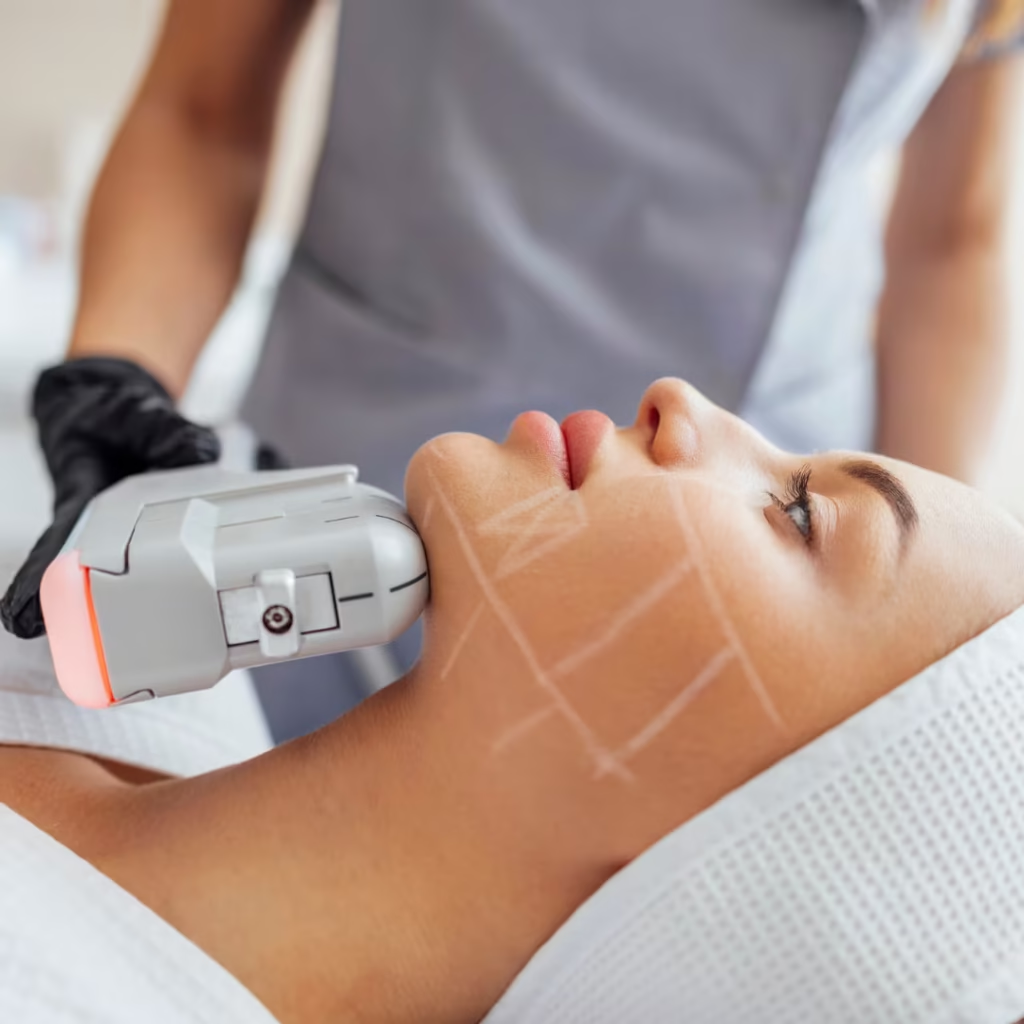The pursuit of youthful skin has led to remarkable innovations in non-surgical treatments.
Among these, Ultherapy and High-Intensity Focused Ultrasound (HIFU) have emerged as leading options for those seeking to rejuvenate and tighten their skin without going under the knife.
Both treatments offer a relatively painless and completely non-invasive way to achieve a facelift-like effect, which explains their rising popularity as alternatives to traditional surgical procedures.
While they share the common goal of stimulating collagen and elastin production to improve skin firmness and elasticity, significant differences exist between these technologies that can impact your treatment experience and results.
This comprehensive guide will delve into the key distinctions between Ultherapy and HIFU, examining their technologies, effectiveness, safety profiles, treatment areas, costs, and results to help you make an informed decision about which treatment might be right for you.
You might be interested: The Complete Guide to Facelift in Singapore
Understanding Collagen and Skin Aging
Before exploring the differences between Ultherapy and HIFU, it’s essential to understand why stimulating collagen and elastin production matters for skin rejuvenation.
Collagen and elastin are the essential proteins that form the foundational structure of our skin. These proteins support the skin’s elasticity and firmness, keeping it looking youthful and vibrant. Unfortunately, as we age, our bodies produce less collagen and elastin, leading to:
- Sagging skin
- Reduced elasticity
- Formation of fine lines and wrinkles
- Overall laxity in facial contours
Both Ultherapy and HIFU technologies work by jumpstarting our body’s natural collagen and elastin production.
They use ultrasound waves that pass through the connective tissues of our skin, heating and causing controlled thermal damage at a deep level.
This damage triggers the body’s healing response, which includes producing fresh collagen and elastin to restore skin strength and firmness.
Read more: Types of Non-Surgical Facelifts in Singapore
The Technology Behind Ultherapy and HIFU

While both treatments utilize ultrasound technology, they differ fundamentally in their approach and precision.
Ultherapy Technology
Ultherapy uses micro-focused ultrasound (MFU) with visualization (MFU-V). FDA-approved in 2004 for non-invasive skin tightening and lifting, it’s widely recognized as the “Gold Standard” in this category.
The procedure uses a specialized applicator to transmit ultrasound energy to the same skin depths that cosmetic surgeons target during surgical facelifts.
The standout feature of Ultherapy is its patented DeepSEE™ visualization technology.
This unique imaging capability allows practitioners to see the structure of the skin, muscles, and bone as they apply the treatment. This real-time visualization enables the practitioner to:
- Evaluate pre-existing collagen levels in a patient’s skin
- Target specific tissue layers for optimal collagen stimulation
- Avoid areas inappropriate for treatment (bones/blood vessels)
- Minimize patient discomfort
- Prevent fat tissue loss
HIFU Technology
High-intensity focused ultrasound (HIFU) is a relatively newer treatment for clinical skin tightening. Approved by the FDA for brow lifts in 2009, it was initially used to treat tumors before being adapted for aesthetic applications.
HIFU works by using an acoustic lens to concentrate several beams of ultrasound energy on targeted areas.
The energy penetrates to a depth between 1.5mm and 4.5mm beneath the skin to stimulate collagen and elastin production.
Unlike Ultherapy, HIFU doesn’t use imaging technology. This means practitioners cannot visualize the layers of skin they’re treating or observe the effects of the beams on the tissue in real-time.
This has earned HIFU the reputation of being a “blind” skin tightening treatment.
Related article: Face Slimming Treatments in Singapore: Achieve a V-Shaped Face Without Surgery
Key Differences in Approach and Precision
The fundamental difference between these two technologies lies in their approach to delivering ultrasound energy to the skin’s deeper layers.
Ultherapy’s micro-focused ultrasound (MFU) method delivers sharply focused energy to specific skin layers with precision guidance through visualization. This allows for accurate targeting of areas with depleted collagen, minimizing the risk of affecting surrounding tissues.
HIFU applies multiple beams that can potentially hit bone and fat tissues in addition to the target areas.
Without visualization, practitioners cannot confirm exactly which tissues they’re treating, leading to less predictable results and a higher risk of complications.
With Ultherapy, you can directly see the muscle, dermis and bone nerves that you want to avoid, and that’s the difference. It gives you a safe, more predictable and effective treatment.”
FDA Approval and Regulatory Status
The regulatory approval status of these treatments further distinguishes them:
Ultherapy’s Regulatory Status
- FDA-approved in 2004 for non-invasive skin tightening and lifting
- The only device with both FDA approval and CE-marking for skin tightening and lifting across the face, neck, and décolletage
- Used to treat over 1.75 million patients globally
- Supported by more than 110 studies and research papers (60 peer-reviewed papers and 50 clinical studies)
HIFU’s Regulatory Status
- Various HIFU devices have different levels of regulatory approval
- Some devices may not have both FDA and CE-marked approval for comprehensive skin tightening and lifting
- The popular Ultraformer HIFU doesn’t have medical FDA approval
- Limited clinical studies on efficacy and patient satisfaction compared to Ultherapy
This disparity in regulatory approval highlights why many medical professionals consider Ultherapy to be the more established and verified treatment option.
You might like: HydraFacial Singapore: Benefits, Costs, Risks
Treatment Areas: Where Ultherapy and HIFU Work Best
The applications for these treatments differ based on their technical capabilities and regulatory clearances.
Ultherapy Treatment Areas

Ultherapy is FDA-cleared specifically for:
- Lifting and tightening the neck
- Under-chin treatments
- Brow lifting
- Improving lines and wrinkles on the chest (décolletage)
With its precision targeting, Ultherapy excels at treating smaller, more delicate areas that require precise lifting and toning.
Read more: Which Skin Tightening Treatments in Singapore is Right For Me?
HIFU Treatment Areas

HIFU can potentially treat:
- Facial tightening and lifting
- Larger body areas (depending on the device)
- Some HIFU devices can target both skin tightening and fat reduction
Some newer HIFU devices like ULTRAcel Q+ come with multiple treatment attachments – one for skin tightening and another specifically for fat reduction, making it a more versatile option for those looking to address both concerns.
Read more: The Ultimate Guide to HIFU Treatment in Singapore
Treatment Depth and Targeting
Both Ultherapy and HIFU can target the skin at multiple depths, which can be adjusted according to a patient’s unique needs.
Ultherapy Treatment Depth
Ultherapy can deliver energy at three precise depths:
- 1.5mm (superficial dermis)
- 3.0mm (deep dermis)
- 4.5mm (SMAS layer – where surgeons typically work during facelifts)
The visualization technology ensures energy is delivered exactly where needed, with practitioners able to see and avoid critical structures like blood vessels and bone.
HIFU Treatment Depth
HIFU typically targets similar depths:
- 1.5mm
- 3.0mm
- 4.5mm
However, without visualization guidance, practitioners rely on experience and anatomical knowledge to estimate the correct placement, which can lead to variation in treatment effectiveness.
Safety Profile: Why Ultherapy Has the Edge
Safety is a critical consideration when choosing between these treatments, and this is where Ultherapy’s visualization technology provides a significant advantage.
Ultherapy Safety Features
- Real-time visualization ensures practitioners can see exactly which tissues they’re treating
- Allows avoidance of blood vessels, bones, and nerves
- Prevents accidental targeting of fat tissues that could lead to volume loss
- More consistent results with lower risk of complications
- Higher standard of practitioner training typically required
HIFU Safety Considerations
- No visualization means practitioners cannot see which tissues they’re treating
- Potential risk of hitting fat cells, blood vessels, or muscle tissues
- Possible destruction of fat cells, potentially leading to facial hollowing
- Risk of damaging bone nerves or muscle tissues
- More variable results depending on practitioner experience
This safety differential is a key reason why many medical professionals recommend Ultherapy, particularly for facial treatments where precision is paramount.
Related article: Best HIFU Treatment Clinic in Singapore
Pain Levels and Treatment Experience
Both treatments involve some discomfort, but patient experiences tend to differ between the two options.
Ultherapy Pain Experience
- Generally described as more intense due to the depth of penetration
- The sensation is often described as brief heat or tingling as ultrasound energy is delivered
- Topical anesthetics or pain medication may be recommended before treatment
- The visualization allows practitioners to avoid sensitive structures, minimizing unnecessary discomfort
HIFU Pain Experience
- Generally reported to cause milder pain
- Sensation varies depending on the treatment area
- Larger treatment areas may still cause discomfort during the procedure
- Without visualization, variable experiences may occur if energy is delivered near sensitive structures
Many practitioners offer numbing creams or other pain management solutions for both treatments to improve patient comfort.
Treatment Duration and Sessions
The time investment for these treatments differs based on their approach and technology.
Ultherapy Treatment Time
- Sessions typically take 60-90 minutes for a full facial treatment
- More time is needed due to the visualization and precise targeting
- Results often achieved with a single treatment
- Maintenance treatments typically recommended annually
HIFU Treatment Time
- Sessions generally range from 30-60 minutes
- Faster treatment times due to broader application of energy
- May require multiple treatments to achieve similar results to Ultherapy
- Maintenance treatments may be needed every 6-12 months
Results and Recovery Time
Both treatments offer the advantage of minimal downtime, but there are differences in how results develop and how long they last.
Ultherapy Results Timeline
- Initial tightening might be visible immediately
- Full results develop over 2-3 months as collagen production increases
- Results can last 12-18 months depending on individual factors
- More dramatic and consistent lifting effects due to precise targeting
- Recommended for patients with moderate skin laxity
HIFU Results Timeline
- Similar to Ultherapy, full results develop over 2-3 months
- Results typically last 6-12 months
- May require more frequent maintenance treatments
- Results can be less predictable due to the lack of visualization
- Often suitable for patients with mild to moderate skin laxity
For both treatments, recovery is minimal:
- Potential slight redness or swelling immediately after treatment
- Possible tenderness in treated areas for a few days
- No significant downtime – patients can resume normal activities immediately
- Sunscreen recommended for treated areas
Cost Comparison: Investment vs. Value
The price difference between these treatments is substantial and reflects their technological distinctions.
Ultherapy Cost Factors
- Generally ranges from $3,000-$4,500 depending on treatment areas
- Higher cost reflects the advanced visualization technology
- Usually achieves desired results in a single session
- Longer-lasting results may mean fewer treatments over time
- Often performed by more specialized practitioners
HIFU Cost Factors
- Typically ranges from $300-$2,500 per area
- More affordable entry point for non-surgical skin tightening
- May require multiple sessions to achieve comparable results
- More frequent maintenance treatments may increase long-term costs
- Available at a wider range of clinics and medspas
When considering costs, it’s important to factor in both the initial investment and the long-term value based on results longevity and maintenance requirements.
Comparisons at a Glance
Here’s a quick reference table comparing the key aspects of Ultherapy and HIFU:
| Feature | Ultherapy | HIFU |
|---|---|---|
| Technology | Micro-focused ultrasound with visualization (MFU-V) | High-intensity focused ultrasound without visualization |
| FDA Approval | Comprehensive approval for face, neck, décolletage | Varies by device; some lack full FDA approval |
| Visualization | Real-time imaging of skin layers | No visualization (“blind” treatment) |
| Precision | High – targets specific tissue layers | Generalized – broader application |
| Safety Profile | Higher due to visualization | Variable depending on practitioner skill |
| Treatment Areas | Specific: face, neck, brow, décolletage | Face plus potential body areas depending on device |
| Pain Level | Typically more intense | Generally milder but varies |
| Session Duration | 60-90 minutes | 30-60 minutes |
| Results Longevity | 12-18 months | 6-12 months |
| Cost | $3,000-$4,500 | $300-$2,500 |
| Research Backing | Extensive (110+ studies) | Limited compared to Ultherapy |
Celebrities and Endorsements
The reputation of these treatments has been enhanced by celebrity endorsements, particularly for Ultherapy.
Celebrities including Jennifer Aniston and Tess Daly have publicly shared their positive experiences with Ultherapy treatments, contributing to its status as the gold standard in non-surgical skin lifting.
While HIFU has gained popularity worldwide, particularly in Asian markets like Korea where aesthetic treatments are highly advanced, it hasn’t achieved the same level of celebrity endorsement in Western markets.
Who Is the Ideal Candidate?
Understanding who benefits most from each treatment can help guide your decision-making process.
Ideal Ultherapy Candidates
- Individuals in their 30s to 60s with mild to moderate skin laxity
- Those seeking treatment specifically for the face, neck, and décolletage
- Patients looking for a one-time treatment with longer-lasting results
- Those who prioritize precision and safety over cost
- Individuals concerned about facial volume preservation
Ideal HIFU Candidates
- Those with mild skin laxity looking for more affordable treatment options
- Patients interested in treating larger body areas beyond the face
- Individuals looking for fat reduction along with skin tightening (with compatible devices)
- Those who prefer shorter treatment sessions
- Patients with higher pain sensitivity may prefer HIFU’s generally milder discomfort
Is Combining Treatments an Option?
Many aesthetic clinics now offer combination approaches that leverage the strengths of both technologies. Some patients benefit from:
- Using Ultherapy for precise facial lifting, particularly in the lower face and neck
- Incorporating HIFU for larger body areas or as a maintenance treatment
- Complementing either treatment with injectables like dermal fillers or bio-remodeling treatments
- Creating a comprehensive treatment plan that addresses both skin laxity and volume loss
Consultation with a qualified practitioner is essential to determine whether a combination approach might yield better results for your specific concerns.
What the Experts Say
Medical professionals generally consider Ultherapy to be the superior option for facial treatments due to its visualization capabilities and extensive research backing. As one Doctor explained:
“What makes Ultherapy a safer and more sophisticated outcome is that we can see what we treat. It’s a bit like driving with a blindfold on.
With Ultherapy, you can directly see the muscle, dermis and bone nerves that you want to avoid, and that’s the difference.
It gives you a safe, more predictable and effective treatment.”
However, many practitioners acknowledge that HIFU has its place in the aesthetic treatment landscape, particularly for patients seeking more affordable options or those looking to treat larger body areas.
Choosing the Right Provider
Regardless of which treatment you select, the practitioner’s experience and qualifications significantly impact your results. Consider these factors when choosing a provider:
- Training and certification specific to the treatment
- Experience with the particular device being used
- Before and after photos of previous patients
- Clinic reputation and reviews
- Transparent communication about expected results
- Thorough consultation process
The best providers will offer honest assessments of which treatment might better suit your specific concerns rather than simply recommending what they have available.
Conclusion: Which Is Better – Ultherapy or HIFU?
The question of which treatment is “better” ultimately depends on your individual needs, goals, and priorities.
Ultherapy stands out for its precision, visualization capabilities, comprehensive FDA approval, and extensive research backing.
It’s generally considered the gold standard for non-surgical facial lifting and tightening, particularly for those who prioritize safety, predictability, and longer-lasting results.
HIFU offers a more accessible price point and versatility for treating multiple areas, including potential body applications.
It may be preferable for those seeking more affordable treatment options or those looking to address larger treatment areas beyond the face.
Rather than asking which is universally better, consider which treatment better aligns with your specific:
- Skin concerns and severity
- Budget constraints
- Pain tolerance
- Treatment area preferences
- Desired longevity of results
For optimal results, consult with experienced practitioners who offer both technologies and can provide personalized recommendations based on your unique needs.
Frequently Asked Questions
Is Ultherapy the same as HIFU?
No, Ultherapy and HIFU are not the same treatment. While both use ultrasound technology to stimulate collagen production, Ultherapy uses micro-focused ultrasound with real-time visualization (MFU-V), allowing practitioners to see the layers being treated.
HIFU uses high-intensity focused ultrasound without visualization capabilities. This fundamental difference affects precision, safety, and results.
How many sessions of Ultherapy or HIFU do I need?
Most patients achieve significant improvement with just one Ultherapy session, with results lasting 12-18 months.
HIFU might require multiple sessions (typically 1-3) to achieve comparable results, with effects lasting 6-12 months.
The exact number of sessions depends on your skin condition, age, and desired outcomes.
Which treatment is more painful, Ultherapy or HIFU?
Ultherapy is generally considered more uncomfortable than HIFU due to the depth of penetration and intensity of the ultrasound energy.
However, both treatments may cause some discomfort, described as a heating or tingling sensation.
Most clinics offer topical anesthetics or pain medication to minimize discomfort during either procedure.
Can Ultherapy or HIFU replace a surgical facelift?
Neither Ultherapy nor HIFU can replace a surgical facelift, particularly for patients with severe skin laxity.
These non-invasive treatments provide modest lifting and tightening effects compared to surgery.
They’re best suited for those with mild to moderate skin laxity or those looking to delay the need for surgical intervention.
Is there any downtime with Ultherapy or HIFU?
Both treatments offer minimal downtime. Patients may experience temporary redness, swelling, tenderness, or tingling in the treated areas, but these effects typically resolve within a few hours to days.
Most people can return to their normal activities immediately after either treatment.
Can Ultherapy or HIFU damage my skin?
When performed by qualified practitioners, both treatments have excellent safety profiles.
Ultherapy’s visualization technology provides an additional safety margin by allowing practitioners to see and avoid critical structures.
HIFU carries a slightly higher risk of complications like uneven results or fat loss if not performed correctly due to its “blind” nature.
How soon will I see results after treatment?
For both Ultherapy and HIFU, some patients notice an immediate tightening effect, but the full results develop gradually over 2-3 months as collagen production increases.
Patience is key, as the most significant improvements typically appear 3-6 months after treatment.
Are the results of Ultherapy and HIFU permanent?
Neither treatment provides permanent results because the natural aging process continues.
Ultherapy results typically last 12-18 months, while HIFU results may last 6-12 months. Many patients opt for maintenance treatments to preserve their results.
Can Ultherapy or HIFU be combined with other treatments?
Yes, both treatments are commonly combined with other aesthetic procedures for enhanced results.
Popular combinations include dermal fillers for volume replacement, bio-remodeling injections for skin quality improvement, and neurotoxins for wrinkle reduction.
Your practitioner can recommend a comprehensive treatment plan based on your concerns.
Which treatment is better for jowls and sagging neck skin?
Ultherapy is generally considered superior for treating jowls and sagging neck skin due to its precision targeting and ability to reach the SMAS layer (the same layer targeted during surgical facelifts).
The visualization technology allows practitioners to focus energy exactly where needed for optimal lifting effects in these challenging areas.
Can HIFU be used for body contouring?
Some advanced HIFU devices can be used for body contouring and fat reduction in addition to skin tightening. Devices like ULTRAcel Q+ offer different attachments specifically designed for fat reduction in areas like the abdomen, flanks, and thighs.
Ultherapy is primarily designed for facial and neck treatments and is not typically used for body applications.
Is one treatment safer than the other during pregnancy?
Neither Ultherapy nor HIFU is recommended during pregnancy.
There have been no specific studies on the safety of these treatments during pregnancy, so most practitioners advise waiting until after childbirth and breastfeeding before undergoing either treatment.
Can these treatments help with acne scars or stretch marks?
Neither Ultherapy nor HIFU is specifically designed to treat acne scars or stretch marks.
While the collagen stimulation may provide some improvement in skin texture, other treatments like microneedling, laser therapy, or radiofrequency treatments are typically more effective for these specific concerns.
How do I know which treatment is right for me?
The best way to determine which treatment is right for you is through a consultation with a qualified aesthetic practitioner who offers both technologies.
They can assess your skin condition, discuss your goals, consider your budget, and recommend the most appropriate treatment plan based on your individual needs.
What is the average cost difference between Ultherapy and HIFU?
Ultherapy typically costs 3-10 times more than HIFU treatments. While Ultherapy ranges from $3,000-$4,500 for a full face and neck treatment, HIFU treatments may start as low as $300-$500 for smaller areas, with full-face treatments typically ranging from $1,000-$2,500.
The price difference reflects the technology differences, particularly Ultherapy’s visualization capabilities and more comprehensive FDA approval.

